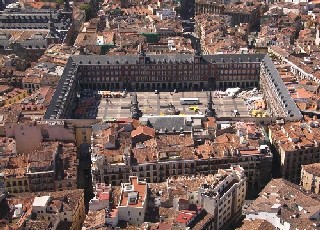
Traditions, Drinks & Live Music
Folk & The City: Madrid, Spain (Part 1)
|
Flamenco Music & Dance ‘Tablaos’
Not being by far any kind of expert in Flamenco music & dance, the main places I can list are:
Bars with Folk Music Activity
So if you have already got a taste of the Flamenco culture, let’s see if you are so lucky to listen to the other Spanish traditional or folk music. The task may not be easy, since there are no stable bars equivalent to the before mentioned tablaos. However, there are a few clubs, keeping a continuous calendar of performances of all kinds, including at least one or two folk music concerts per month. Such places are for example:
Irish Pubs
Spain has many cities with probably some of the largest numbers of bars, restaurants, discos… per square kilometre that you can find in the world. Nothing to be extremely proud of, but it explains why since the late 80’s, it has attracted Irish beer brewers to open hundreds of elegantly decorated old fashioned traditional Irish pubs in most cities and towns. Madrid city maybe takes the lead on this, in number and size of such kind of businesses: easily more than thirty, just in the downtown area.
This could create some expectation to find Irish trad music sessions & concerts resembling a bit Dublin’s Temple Bar area. But… lets see. Some owners and staff of these pubs in Madrid (Irish people in many cases), have initially given an honest try to live music events. Sometimes even hiring bands and trad session leaders brought from Ireland, and inviting Irish music players from many places. But in spite of their good intentions, they are well aware that nothing fills up their pubs every night, as the classic matches: Premier League, Liga Española, Gaelic Sports, Six Nations,... Large TV screens have taken a dominant place for the football and rugby fans meeting there, many of them Irish and British people living in Madrid. In most Irish and folk music concerts or sessions that I have been to in these pubs in Madrid, I have not noticed much interest (or even respect) in the customers (Spanish or not), who seem to consider the musicians and their activity just as part of the decoration. Quite different from what I have seen in the pubs in Ireland, where the musicians and their show seem to deserve better consideration from the audience.
But being fair, from the list of Irish pubs in downtown Madrid, at least a few of them still dedicate a respectable number of hours a week to live music (even more around the 17th of March: Saint Patrick’s day). There are several other pubs sometimes programming live music in Madrid (O’Connor’s, La Fontana de Oro, The Quiet Man, Molly Malone’s, Moore’s, Finnegan’s…), but for now I will just mention three that have (or had) a more conscious attitude towards Irish, Celtic & folk in general :
Other Taverns
If you had enough cider and ‘black’ beer, there are also a couple of recommendations for food & drink places, not really for live folk music, but somehow related with it. These are also in Madrid’s ‘Barrio de las Letras’:
|
Madrid in 2009 is an almost 6 million people metropolitan area right in the centre of the Iberian Peninsula. That means ‘conveniently located’ if you also want to travel to any other region in Spain, or even to Portugal. Madrid city & its outskirts is an Autonomous Community in itself. It is surrounded by the communities of Castilla-Leon (North) and Castilla-La Mancha (South). Therefore, the traditional music of the Madrid area is mainly related to these two neighbouring regions too.
However, the local music in the Madrid region has suffered during the last decades, a decay of its most rooted traditions. There are several records of different types of local songs, dances, instruments, etc… which were peculiar of Madrid’s villages. But as in any big urban area, the industry, population, life styles… have continuously evolved, and many local traditions have almost totally extinguished.

If you arrive to Madrid around the 15th of May, it is probably the only time of the year when the city downtown and some of its inhabitants, rescue the remains of the ‘old’ traditions to celebrate the day of the local patron saint: San Isidro.
Madrid city has been open to integrate music traditions from many other parts of Spain or abroad. Example: The kind of local dance tune that is considered the most typical of the ‘old Madrid downtown’, is called ‘Chotis’, and is known here since the 19th century. The name is presumed to be an evolution of the word ‘Schottische’, which was a kind of slow polka original from Bohemia.
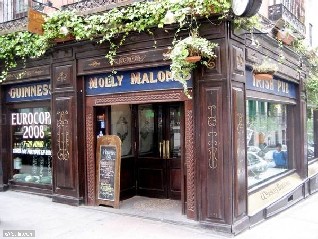
Madrid became the political centre of Spain in 1561. Its old town starts (West) at the Palacio de Oriente (the old residence for the royal families and their court). Then it extends towards the East, with neighbourhoods and buildings of ancient architecture (nine centuries old, some of them), including the Museo del Prado, the national gallery of paintings.
Places of interest for a folk music fan, are mostly dispersed along the streets of that old Madrid, and range from ‘Tablaos Flamencos’ (taverns with flamenco music shows) to Irish pubs, or rock and jazz clubs, which dedicate certain concerts to Spanish and foreign folk music bands.
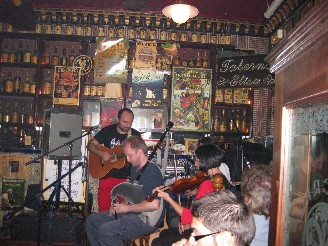
There is a frequent differentiation that we make over here, between Flamenco and “the other Spanish traditions on folk music”. To better explain this duality, I like to compare it with the music of North America. Over there you find two (maybe three) highly popular styles of traditional music, such as Country or Blues, mostly original from Western and Southern states. And then you can also hear a variety of much less popular music traditions, geographically spread from the borders with Mexico up to Canada (Cajun, Zydeco, Blue Grass, North American folk songs,…).
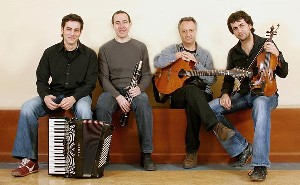
In Spain, Flamenco would be our equivalent to Blues or Country music in the USA. It belongs mainly to the Southern region of Andalusia, its surrounding Communities and several Spanish cities. And then we also have, in a more limited level of popularity, different traditional music in each and all parts of Spain, including the islands ( Balearic and Canary ).
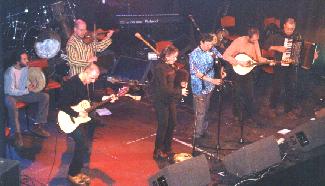
I guess that a first list of tips for live traditional & folk music places in downtown Madrid, should go as follows (see box on the right). Of course, all the above lists are susceptible to growth (if bar owners establish new initiatives), or shrinking (as places change or go out of business). We will see how all this evolves as we all go thru today’s world economical crisis. I leave that for some future article.
Photo Credits:
(1) Plaza Mayor, Madrid,
(2) Molly Malone’s Pub,
(3) Balbarda playing in
Taberna Elisa
(by Pio Fernández);
(4) La Musgana (from website);
(5) Berrogüetto (by The Mollis).
|
To the German FolkWorld |
© The Mollis - Editors of FolkWorld; Published 03/2009
All material published in FolkWorld is © The Author via FolkWorld. Storage for private use is allowed and welcome. Reviews and extracts of up to 200 words may be freely quoted and reproduced, if source and author are acknowledged. For any other reproduction please ask the Editors for permission. Although any external links from FolkWorld are chosen with greatest care, FolkWorld and its editors do not take any responsibility for the content of the linked external websites.
